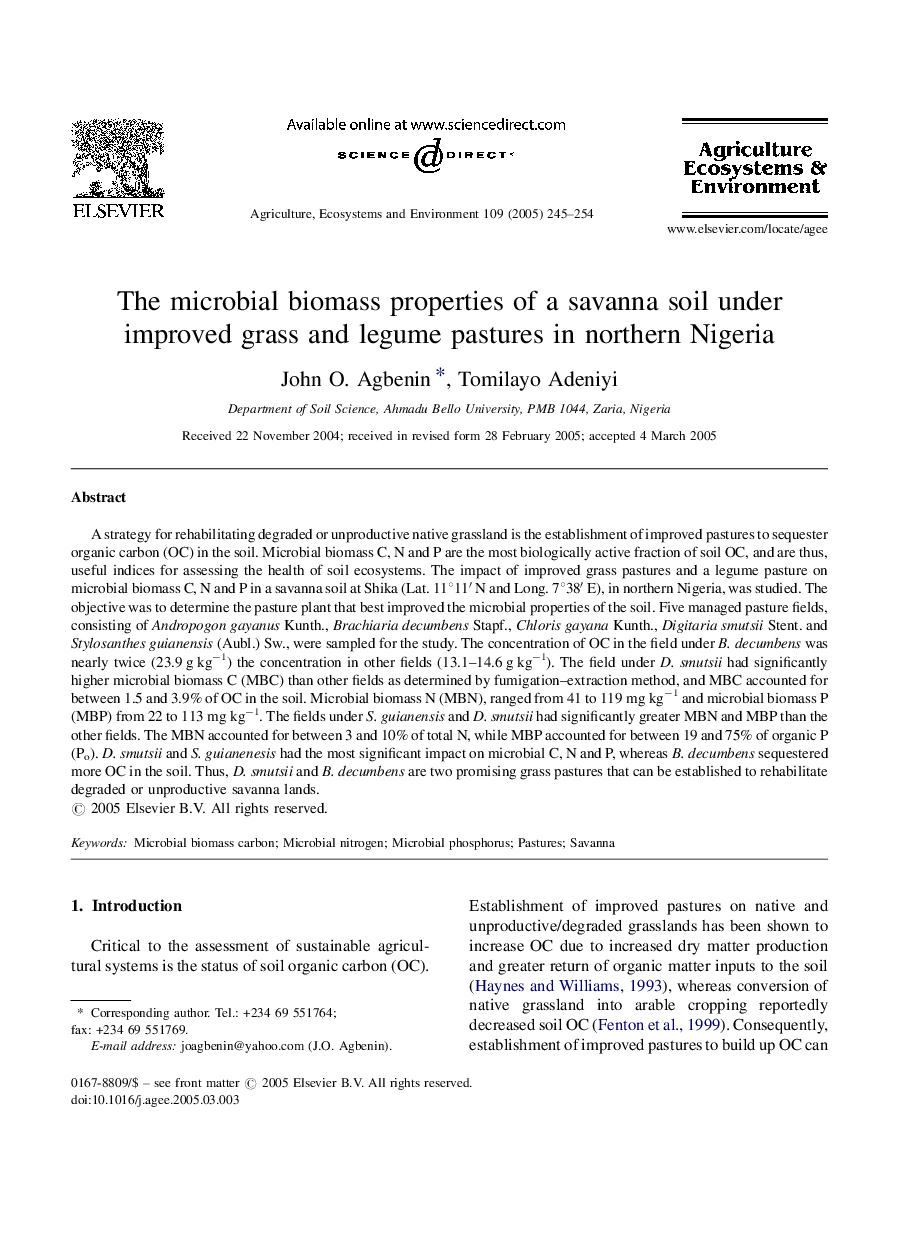| کد مقاله | کد نشریه | سال انتشار | مقاله انگلیسی | نسخه تمام متن |
|---|---|---|---|---|
| 8970754 | 1552155 | 2005 | 10 صفحه PDF | دانلود رایگان |
عنوان انگلیسی مقاله ISI
The microbial biomass properties of a savanna soil under improved grass and legume pastures in northern Nigeria
دانلود مقاله + سفارش ترجمه
دانلود مقاله ISI انگلیسی
رایگان برای ایرانیان
کلمات کلیدی
موضوعات مرتبط
علوم زیستی و بیوفناوری
علوم کشاورزی و بیولوژیک
علوم زراعت و اصلاح نباتات
پیش نمایش صفحه اول مقاله

چکیده انگلیسی
A strategy for rehabilitating degraded or unproductive native grassland is the establishment of improved pastures to sequester organic carbon (OC) in the soil. Microbial biomass C, N and P are the most biologically active fraction of soil OC, and are thus, useful indices for assessing the health of soil ecosystems. The impact of improved grass pastures and a legume pasture on microbial biomass C, N and P in a savanna soil at Shika (Lat. 11°11â² N and Long. 7°38â² E), in northern Nigeria, was studied. The objective was to determine the pasture plant that best improved the microbial properties of the soil. Five managed pasture fields, consisting of Andropogon gayanus Kunth., Brachiaria decumbens Stapf., Chloris gayana Kunth., Digitaria smutsii Stent. and Stylosanthes guianensis (Aubl.) Sw., were sampled for the study. The concentration of OC in the field under B. decumbens was nearly twice (23.9 g kgâ1) the concentration in other fields (13.1-14.6 g kgâ1). The field under D. smutsii had significantly higher microbial biomass C (MBC) than other fields as determined by fumigation-extraction method, and MBC accounted for between 1.5 and 3.9% of OC in the soil. Microbial biomass N (MBN), ranged from 41 to 119 mg kgâ1 and microbial biomass P (MBP) from 22 to 113 mg kgâ1. The fields under S. guianensis and D. smutsii had significantly greater MBN and MBP than the other fields. The MBN accounted for between 3 and 10% of total N, while MBP accounted for between 19 and 75% of organic P (Po). D. smutsii and S. guianenesis had the most significant impact on microbial C, N and P, whereas B. decumbens sequestered more OC in the soil. Thus, D. smutsii and B. decumbens are two promising grass pastures that can be established to rehabilitate degraded or unproductive savanna lands.
ناشر
Database: Elsevier - ScienceDirect (ساینس دایرکت)
Journal: Agriculture, Ecosystems & Environment - Volume 109, Issues 3â4, 1 September 2005, Pages 245-254
Journal: Agriculture, Ecosystems & Environment - Volume 109, Issues 3â4, 1 September 2005, Pages 245-254
نویسندگان
John O. Agbenin, Tomilayo Adeniyi,